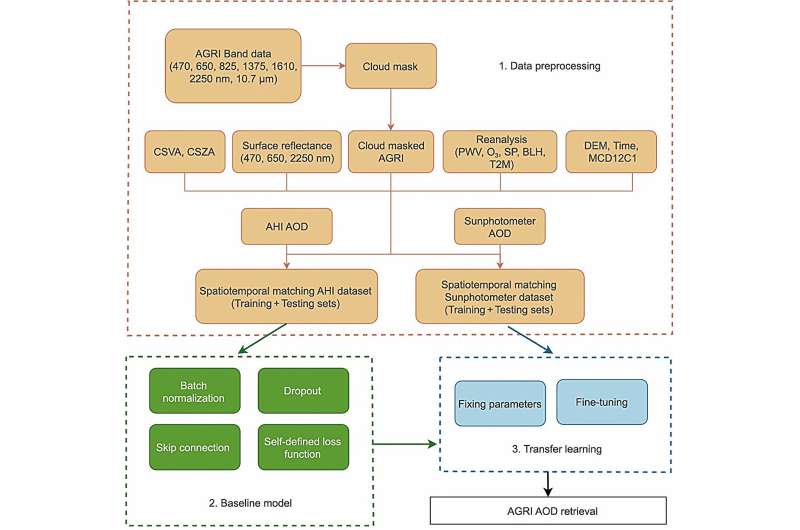This article has been reviewed according to Science X's editorial process and policies. Editors have highlighted the following attributes while ensuring the content's credibility:
fact-checked
proofread
A deep-learning and transfer-learning hybrid aerosol retrieval algorithm for a geostationary meteorological satellite

A study published in Engineering introduces an innovative high-precision aerosol algorithm for a geostationary meteorological satellite.
Entitled "A Deep-Learning and Transfer-Learning Hybrid Aerosol Retrieval Algorithm for FY4-AGRI: Development and Verification over Asia", the research article presents a hybrid approach that addresses the challenges posed by the inflexibility of traditional physical algorithms and the limited number of ground-based sunphotometer sites required for machine learning.
The proposed method uses an aerosol optical depth (AOD) retrieval algorithm that exploits deep learning and transfer learning. The algorithm integrates the core ideas of the dark target and deep blue algorithms to facilitate feature selection for machine learning algorithms.
The process involves two main steps: initially, employing 10 min Advanced Himawari Imager (AHI) AOD as a target to construct a deep neural network (DNN) with residual networks; subsequently, fine-tuning the DNN parameters utilizing AOD data from 89 solar photometer-equipped ground stations.
Independent validation demonstrates the high accuracy of the algorithm in retrieving Advanced Geosynchronous Radiation Imager (AGRI) AOD, achieving a coefficient of determination of 0.70 and a mean bias error of 0.03, with 70.7% of the data within the expected error range. Notably, during extreme aerosol events, the retrieval aptly captures the temporal evolution of these phenomena.
This study has demonstrated the great potential of combining the physical approach and deep learning in geoscientific analysis. Moreover, the proposed algorithm exhibits versatility, offering applicability to other multispectral sensors.
The main contributions of this study are:
- A hybrid deep learning and transfer learning aerosol retrieval algorithm is proposed.
- The algorithm leads to better AGRI AOD retrievals compared to previous studies.
- AGRI AOD provides more detailed information about aerosol events than the daily multi-angle implementation of atmospheric correction (MAIAC) AOD.
In conclusion, the study introduces a pioneering hybrid aerosol retrieval algorithm tailored for geostationary meteorological satellites. By integrating deep learning and transfer learning techniques, the algorithm overcomes the limitations of traditional physical algorithms and the scarcity of ground-based data sources. Furthermore, the algorithm's applicability to other multispectral sensors opens avenues for broader applications in geoscientific analysis.
More information: Disong Fu et al, A Deep-Learning and Transfer-Learning Hybrid Aerosol Retrieval Algorithm for FY4-AGRI: Development and Verification over Asia, Engineering (2024). DOI: 10.1016/j.eng.2023.09.023


















